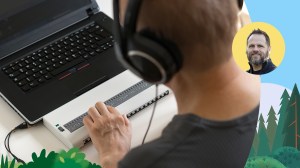Today, Salesforce joins community organizers, industry partners, and advocates around the world in observing Global Accessibility Awareness Day (GAAD).
Derek Featherstone, Salesforce’s new Vice President of Accessibility and Inclusive Design, shares his view on the history and state of accessibility in tech, how to take action on this important day, and how he’ll help deliver on Salesforce’s mission of building better technology for all.
Q: You’ve been involved in product accessibility and inclusion for a long time. How did you get your start in this space?
Working as a developer in the early 2000s, I learned that simply meeting accessibility guidelines like WCAG (the Web Content Accessibility Guidelines) didn’t always translate to a great user experience. We’d create products that were compliant and met WCAG requirements, but when conducting usability studies with people with disabilities, we’d find that the solutions we created weren’t always easy to use.
Practicing inclusive design by engaging people with disabilities as co-designers helps us create innovative products that are accessible and easy to use for everyone.
Derek Featherstone
Those early experiences made clear that accessibility compliance is a minimum technical standard. These standards serve as a great place to begin, but not a place to end.
Since then, I’ve worked to find ways for businesses to be more holistic about accessibility — primarily by working with people with disabilities during the design and development process.
Practicing inclusive design by engaging people with disabilities as co-designers helps us create innovative products that are accessible and easy to use for everyone.
Q: Tech moves pretty fast. What’s changed since you first got involved in this work?
People that use technology now have much higher expectations than they did 20 years ago for quality, performance, speed, and trust. Consumers are no longer willing to accept something that works but doesn’t truly take their needs into account.
People also expect to be included, heard, and respected as part of the creation process – and they want products that are accessible and easy to use.
I’m glad to see the tech industry shift away from just checking boxes on a list of guidelines to instead focus on how usable a product is in real life, by real people.
We are also looking at accessibility and inclusion as a source of innovation. By widening our perspective on who uses our products, we can discover opportunities we miss when we only think about abled users. Slack’s accessibility features are a great example of a widened perspective.
Q: Is there anything that hasn’t changed over the years?
One fundamental truth remains the same. Technology and products that are confusing or difficult to use by disabled people are almost always confusing and difficult to use for people without disabilities too.
Q: Looking more broadly, where do you feel like the tech industry is succeeding on accessibility, and where can it still improve?
Leaders in the industry are getting better at talking about accessibility and connecting it to Diversity, Equity, and Inclusion. But that hasn’t had a massive impact on creating widespread accessibility – at least not yet.
By including disabled designers, managers, advocates, and testers, businesses can get valuable insights based on people’s lived experiences with disability.
Derek Featherstone
It’s great that there’s more attention and focus on creating accessible products and considering a wider range of users, but we can always improve by inviting diverse co-designers into the product design and development process.
By including disabled designers, managers, advocates, and testers, businesses can get valuable insights based on people’s lived experiences with disability. And these insights ultimately help businesses go beyond the bare minimum and move towards innovation.
The earlier you can address accessibility and inclusion, the less time you spend going back and spending money to solve problems that could have been avoided by being more inclusive up front.
Q: What’s your vision for driving more accessible products and greater inclusion in the design process at Salesforce?
Ultimately, our vision is to be as proactive as possible when it comes to accessibility and inclusion.
At Salesforce, we’re looking for ways to “shift left.” That doesn’t ONLY mean testing earlier and resolving accessibility issues quicker – it means distributing accountability and responsibility for accessibility throughout the organization. Everyone has a role to play, so giving as many teams as possible the tools and resources to make accessibility a core part of what they do — as opposed to a box to check — is how we take our principles and make them work at scale.
We want to make sure that decisions about accessibility are happening intentionally and with disabled people at the table, so we can impact the day-to-day decision making that goes into building our products.
Q: Today is Global Accessibility Awareness Day. What actions can companies take today — and in the future — to build the best experience for users with disabilities?
Take action. Engage and include disabled people as soon as possible in the design process. That might mean something as simple as talking with a few people with disabilities before you start designing and developing a new product. Or it might mean something at a larger scale – getting feedback from people with disabilities on your early prototypes, or leveraging other design research like a usability study.
Regardless of what scale you’re operating at, my advice is to make simple commitments and stick to them. If you bring one more voice to the table tomorrow, you’ll make more progress than you did today.
The steps involved might look different at each company, but any business can include the perspectives of disabled designers, managers, specialists, and customers. And the more partnership we can unlock, the more progress we can make on building inclusive products and experiences — together.
For more about Derek’s team and the work they do at Salesforce, check out the product accessibility and inclusive design webpage, or read up on ethics at Salesforce.


















